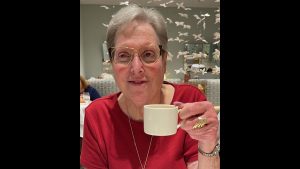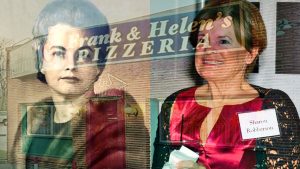Sukkahs are family traditions
Published October 8, 2006
Sukkah squads were busy last week as they helped erect the small and large huts for the holiday of Sukkot. It is the last of the three pilgrimage holidays and is celebrated five days after Yom Kippur. It commemorates the history of the Jews wandering in the desert for 40 years living in temporary huts. It is also a harvest festival and sometimes referred to as the Festival of Ingathering.
Historically or agriculturally, it is a joyous festival. Jews are commanded to build booths (sukkot) to live in like their ancestors in the wilderness. Families eat in their sukkah and sometimes sleep in them, weather permitting. Inviting friends and family over to share a meal is an important part of the holiday.
More than 500 people at Congregation Shaare Emeth were expected to have attended sukkah parties after being matched with a host in their neighborhood. The “Sukkot in the Neighborhood” event is one of the many activities of the congregation’s Simchat Sukkot festivities which is the brainchild of program director Ronnie Brockman. The program was made possible with a grant through the Gladys K. Crown Foundation, honoring the memory of Shirlee Green and the Rich Education Fund of the Jewish Federation.
“The goal of the sukkah in the neighborhood program is to touch people where they’re at: in their homes, their community and their synagogue,” Brockman said. “One of the lessons of Sukkot is welcoming the stranger. What better way for the community to perform that mitzvot than having sukkah parties.”
Congregation Shaare Emeth member Dana Albright helped match the hosts with guests for the sukkah parties. She grew up having a sukkah and remembers her mother making a pot of chili to share with the many visitors who would stop by to share a meal. The holiday “embedded good feelings” said Albright and was a nice way to celebrate this time of year.
“It is such an exciting piece for our congregation to provide this opportunity to do Jewish at home,” Albright said. “People have really warmed to the idea and are excited about it. They are looking forward to being together, meeting new people and being with old friends.”
Some of hosts have had a sukkah before and some are building a sukkah for the first time. Part of the grant money included an allocation for sukkah kits making it possible for some members to have a sukkah for the first time. People hosting parties received sukkah bags filled with grape juice, candy, arts and crafts and educational materials to enhance their celebrations. Hosts were also provided with lulav and etrog.
“It is such a mitzvah to build a sukkah,” Rick Kodner said. “Our rabbi teaches us even if someone can’t observe the holiday for the entire week — and it is quite a commitment to observe the whole week — whatever you can do is good.”
The first sukkah Brith Sholom Kneseth Israel member Kodner remembers having as a child used a swing set as its frame. It stood in the backyard between Kodner’s house and his cousin’s house. Kodner remembers his father and uncle removing the swings and building the sukkah around the swing set. As the children grew older, the sukkah became too small so they built a “bigger sukkah using bigger materials.” Kodner’s mother used camouflage canvas material for the sides. Those same camouflage canvas sides are used by Kodner for his own sukkah.
“So our sukkah today has meaning from when I was a child as well,” Kodner said.
Kodner’s family eats in their sukkah every evening except for the night when they eat at Solomon Schechter Day School which sponsors a family night for the holiday. The Kodners always invite people over to share the meal and usually there are eight to fifteen people for dinner every evening. One evening is dedicated to the family including the parents, aunts, uncles, nieces and nephews. Each year they try to invite different people and many times will include non-Jewish guests.
“We try to invite people who work at or are affiliated with Solomon Schechter,” Kodner said. “They are surrounded by Jewish traditions day in and day out. It is nice for them to be able to experience the holiday and actually get to see for themselves a little bit of what we do.”
There is a wealth of material about Sukkot on the internet to enhance celebrations whether you are throwing your first sukkah party or your twentieth. There are recipes, traditions, readings, games, decorating ideas and lots of educational materials. The Kodner family discovered discussion questions on one website and will be using them for the first time this year.
“Each year we build on the year before,” Kodner said. “This year will be even better than last year. This way, just like I had a tradition growing up with my family, so too, our children will have something to build on.”
Traditional Congregation member Zumi Brody admits his early memories of Sukkot had to do with having a family who was “handiwork challenged.” They had a metal kit sukkah and it was quite an ordeal to put it together. Once he got older he developed a knack for putting it together quicker. The completed sukkah was rather small and provided a “tight fit” for their family of six.
“Building the sukkah is kind of like our reward for getting through the High Holidays,” Brody said. “This holiday especially commands us to be joyous.”
When Brody married his wife Caryn, she custom designed their new sukkah. They went to Home Depot and bought PVC piping, tarps and pulleys. One good thing about designing your own sukkah is being able to build it to your own specifications, according to Brody. Now they have a very large sukkah. Though it does take a little longer to build since it isn’t from a kit and there were a few trials and errors.
“When we first moved to St. Louis we weren’t aware of everything,” Brody said. “It was windy and the sukkah came crashing down. So we made a couple of adjustments. Unfortunately the weather was bad the second year and it came crashing down again.”
The Brodys’ children are still very young so they are just beginning to create traditions with them. He remembers a particular tradition started by his father: they would sing songs from Yom Kippur in the sukkah on the first night of the holiday.
“The person who led the davening after Kol Nidre where I grew up had a great voice,” Brody said. “My father used to love to sing those tunes on the first night of Sukkot. When my parents have visited on Sukkot we have kept up that tradition.”
Certain things, like building a sukkah, connect Brody with the historical aspect of the Jewish people. He’s very cognizant of the fact the Jewish people have built sukkot for literally thousands of years. Not having a kit ties him back to his ancestors who also didn’t have kits. Trying to figure out what will fall down this year is part of the holiday for Brody.
“A sukkah is supposed to be temporary,” Brody said. “Mine is truly temporary — after all, it broke two years in a row.”
Julie Eisenberg did not have a sukkah growing up and only remembers celebrating the holiday during Sunday school. She currently attends services at Bais Menachem — Chabad and is also a member of B’nai Amoona. Recently their family started taking on a more traditional lifestyle and bringing more traditions into their home.
Rabbi Yosef Landa helped them order their first sukkah over 10 years ago. It was easy to assemble and held 10 people. This year they have a larger new sukkah which holds 20 people. Every night they try to eat in the sukkah. They always invite family and friends over for meals and to celebrate. Eisenberg is looking forward to adding new decorations for the new sukkah and adding something new each year so it looks festive. She is contemplating one new decorating tradition she saw at a friend’s sukkah.
“Our friends Debbie and Jesse Barasch have a sheet on one side of their sukkah,” Eisenberg said. “Over the years everyone who comes to their sukkah signs their name on the sheet with the date.”
It was especially important to Eisenberg as the mother of four daughters to show them tradition. She likes to incorporate traditions into their household in a joyous way. Sukkot gives her a chance to do something a little bit different for the children to experience the holiday in a positive way.
“It is really important in this day and age to bring more and more traditions into family life; in a positive way; with really great energy so the kids have something to hold on to,” Eisenberg said.













